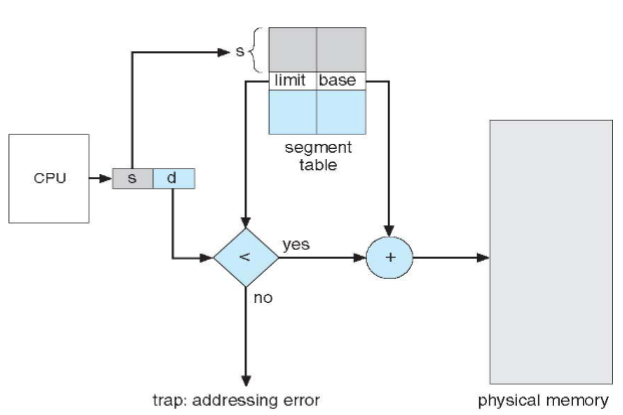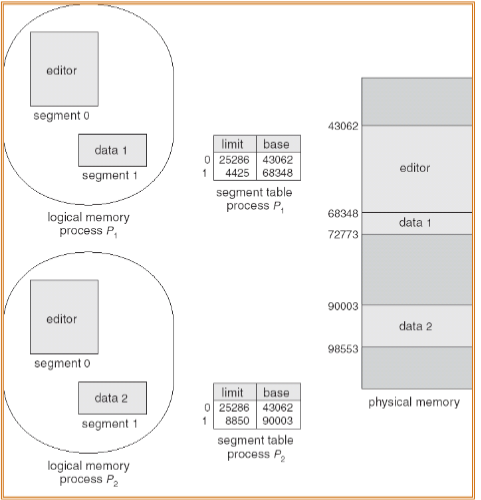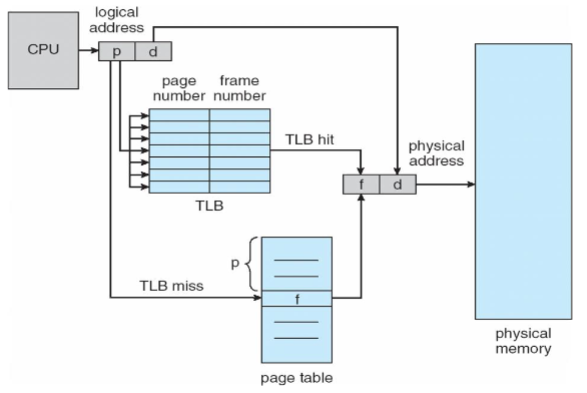COMP 3511: Lecture 18
Date: 2024-11-05 14:24:18
Reviewed:
Topic / Chapter:
summary
❓Questions
Notes
Segmentation
-
Segmentation architecture
- logical address: consists of
two-tuple- segment-number, offset
- segment table: maps 2D programmer-defined address into 1D physical address
- each entry: contains:
base: containing starting physical address of each segmentlimit: specifying length of segment
- each entry: contains:
- both STBR / STLR: stored in PCB of a process
- segment-table base register (STBR): points to segment table's location in memory
- segment-table length register (STLR): indicating no. of segments used by program
- segment no. : legal if
- protection: each entry in segment table associating w/
validation bit = 0: illegal segment- 👨🏫 part of protection bit
- read / write / execute privileges

- protection bit: associated w/ each segment
- code sharing: occurring at segment level
- each segment: vary in length
- thus dynamic storage allocation problem still exists
- yet, much less severe as each segment: considerably smaller than entire memory space
- process: might share data
- simply use same base & limit in segmentation table for shared segment!

- logical address: consists of
-
Summary segmentation
- protection: easy in segment table
- code segment: read-only
- data & stack: read-write, etc.
- address: can be outside valid range
- as stack & heap: allowed to grow
- system automatically increase the size of stack
- main program w/ segmentation
- dynamic storage allocation problem and external fragmentation persists
- may move processes multiple times to fit everything
- from processor view: good & easy
- protection: easy in segment table
Paging
-
Paging
- divide physical memory into fixed-sized blocks: frames
- usually power of 2: between
4 KB(12 bit offset) to1 GB(30 bit offset)- defined by the hardware
- 👨🏫 frame number: unique in physical address
- usually power of 2: between
- divide logical memory into: blocks of same-size pages (same size as frame)
- OS: keep track of all free (physical) frames available in main memory
- to run program of size pages: find free frames (non-contiguous) in memory
- page table: used for translating logical to physical address
- yet: suffers from internal fragmentation in last page / frame
- divide physical memory into fixed-sized blocks: frames
-
Address translation scheme
- address generated by CPU: 2 parts
- page number (p): index for page table
- containing base address of each page in physical memory
- page offset (d): combined w/ base address to define physical memory
- page number (p): index for page table
page number page offset - page size / frame size: fixed
- same for size of page
- for bits logical address, logical address space: bytes
- if page size / frame size
- no. of pages:
- example
- let page no. -bit, page off set -bit
- then page size: KB
- 32 bit virtual address: shows GB
- 20 bits for page no.: no. of pages
- address generated by CPU: 2 parts
-
Paging hardware
- steps:
- extract page no. and use it for page table index
- extract corresponding frame no. from page table
- replace page no. with frame no.

- offset : doesn't change, but replaced
- frame no. & offset: not gives physical address
- steps:
-
Paging example

- frame no.: automatically derive from starting address of each frame
- : means logical address of bytes
- logical address : page 0 & offset 0
- page 0 = frame 5 (from table)
- logical address 0: physical address
5<<n + 0 = 20 - logical address
3=(0,3): physical address5<<n + 3 = 23 - logical address
4=(1,0): physical address6<<n + 0 = 24 - logical address
13=(3,1): physical address2<<n + 1 = 9
- : each page size: bytes
- calculating internal fragmentation
- page size:
2,048bytes (2KB) - process size:
72,766bytes - 35 pages + 1086 bytes
- internal fragmentation:
2,048 - 1,086 = 962bytes - worst case fragmentation:
1 frame - 1 byte - average fragmentation:
1/2 frame
- page size:
- is small frame: desirable?
- page size: grown over time
- SubMicro Solaris: support 8 KB and 4 MB
- process & physical memory view: very different
- for programmer: memory is contiguous
- actually: no
- for programmer: memory is contiguous
-
Implementation of page table
- page table: in main memory
- PCB: keep track of memory allocation for process
- page-table base register (PTBR):
- page-table length register (PTLR):
- under the scheme: every data / instruction access requires two memory access
- one for page table (translation) and another for fetching data
- associative memory / translation look-aside buffers
- page table: in main memory
-
Associative memory
- a parallel search
- address translation
- check all entries in parallel
- TLB: shared & used by all processes
- (w/ PID and page number)
- if : in associative register: get frame no. out: (TLB hit)
- else: bring the entry to TLB / memory
- check all entries in parallel
- locality on TLB
- instruction: usually stays on the same page (sequential access nature)
- stack: exhibits locality (pop in & out)
- data: less locality, still quite a bit
-
Paging hardware w/ TLB
